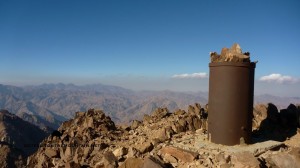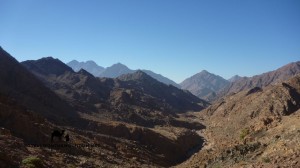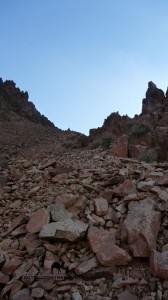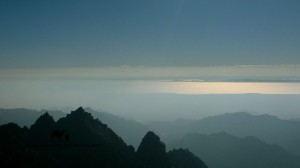September 22, 2014
Jebel Thebt: a Sinai giant
 Jebel Thebt is one of Sinai’s biggest peaks. Compared with the other big mountains though, it doesn’t get hiked much. That’s partly because it’s so isolated and hard to get to. Wherever you start, it’s a long walk in. You can knock the first few kilos off with a jeep but even then there’s a day’s walk to the mountain afterwards. As much as the isolation, its popularity was limited by the fact it wasn’t mixed up with the Biblical legend that made other mountains so famous. It never really got visited, talked-about, or put down on the map by early explorers. Not like other peaks did. Anyway, I hope more hikers start doing this one day. Because it’s a big, brooding giant of a peak that deserves better; one of the Sinai’s classic adventures, with some of its most stunning views.
Jebel Thebt is one of Sinai’s biggest peaks. Compared with the other big mountains though, it doesn’t get hiked much. That’s partly because it’s so isolated and hard to get to. Wherever you start, it’s a long walk in. You can knock the first few kilos off with a jeep but even then there’s a day’s walk to the mountain afterwards. As much as the isolation, its popularity was limited by the fact it wasn’t mixed up with the Biblical legend that made other mountains so famous. It never really got visited, talked-about, or put down on the map by early explorers. Not like other peaks did. Anyway, I hope more hikers start doing this one day. Because it’s a big, brooding giant of a peak that deserves better; one of the Sinai’s classic adventures, with some of its most stunning views.
The Bedouin climbed Jebel Thebt ages ago. The first European ascent I know of was made by the Rev F.W Holland in 1867. I meant to do it in 2012 but ran out of time trying to find a way up a nearby peak called Jebel Rimhan.
I finally got round to it again in the depths of winter 2014, going with a chain-smoking Bedouin of the Jebeleya tribe, called Musa.
We walked in from St Katherine and slept the first night in Wadi Tarfa; an old travelling passage between the Monastery of St Katherine and El Tur. It was absolutely freezing and everything was white with frost in the morning – Musa included. He was in one of those flimsy-type sleeping bags you’d take to Glastonbury or T-in the Park or something; doubled up with his knees to his chest, not moving. Half-worried he’d frozen to death, I nudged him which made him suddenly sit bolt upright, like a jack in the box. He stared at me a few seconds, then the fire, then me again; all with the confused look of a man who’d totally forgotten where he actually went to sleep.
We’d both overslept by a couple of hours. Which meant getting to Jebel Thebt and back in the couple of days we had was going to be tough.
 Normally, to get to Jebel Thebt, you’d keep walking down Wadi Tarfa. Musa had a shortcut in mind though, which was just as well; because we’d never have got there the normal way. Not before sunset, anyway. And the last thing I wanted was to be stuck out on a big peak I didn’t know in the cold depths of a Sinai winter (according to one early climber, a Bedouin guide got frostbite on a mountain near Jebel Thebt in 1898). We clambered out of Wadi Tarfa and went over low, rocky hills. Sure enough, Musa’s shortcut was spot on. Jebel Thebt soon appeared on the horizon. Still huge. STILL faraway. It’s that highest, most distant peak on the left in the picture above. We went down to a wadi – Wadi Thebt – and began a long uphill slog to the bottom of the mountain.
Normally, to get to Jebel Thebt, you’d keep walking down Wadi Tarfa. Musa had a shortcut in mind though, which was just as well; because we’d never have got there the normal way. Not before sunset, anyway. And the last thing I wanted was to be stuck out on a big peak I didn’t know in the cold depths of a Sinai winter (according to one early climber, a Bedouin guide got frostbite on a mountain near Jebel Thebt in 1898). We clambered out of Wadi Tarfa and went over low, rocky hills. Sure enough, Musa’s shortcut was spot on. Jebel Thebt soon appeared on the horizon. Still huge. STILL faraway. It’s that highest, most distant peak on the left in the picture above. We went down to a wadi – Wadi Thebt – and began a long uphill slog to the bottom of the mountain.
I’d be going alone now. Me and Musa had already agreed he’d sit the climb out.
Looking at it now though, I sort of wished I’d persuaded him to come. It still looked massive. And difficult. And there wasn’t much time left.
Getting up Jebel Thebt is a two-step process. You follow the last stretch of Wadi Thebt up to a high pass. Then you turn and make a beeline straight for the top. It sounds easy but it’s a bit tricky in a rush.
 There are no good trails. It’s hard to see where you’re going. You start on one side of the wadi. But further on, big crags block it. You can cross to the other side, but there are huge scree slopes here. And not the sort of scree slopes whose bulges have been flattened out by hundreds of hikers’ feet. Or lined with nice neat trails. Precarious scree slopes that feel like they’re going to slide out from under your feet at any moment, sweeping you away in an avalanche of rubble. If these scree slopes have ONE redeeming feature though it’s that they’re where a few rojoms – trail-marking stones – appear on the mountain for the first time.
There are no good trails. It’s hard to see where you’re going. You start on one side of the wadi. But further on, big crags block it. You can cross to the other side, but there are huge scree slopes here. And not the sort of scree slopes whose bulges have been flattened out by hundreds of hikers’ feet. Or lined with nice neat trails. Precarious scree slopes that feel like they’re going to slide out from under your feet at any moment, sweeping you away in an avalanche of rubble. If these scree slopes have ONE redeeming feature though it’s that they’re where a few rojoms – trail-marking stones – appear on the mountain for the first time.
Rojoms mark the way in hard-to-navigate parts of the Sinai. And they give you that important psychological security of knowing you ARE on the right trail. If you’re ever in a tricky place like this in the Sinai and you know the exact route, DO build them. Obviously, if you don’t; don’t. The last thing anybody needs is to be led off on a meandering, dead-man’s trail in places like this.
Anyway, after this scree, you get to the pass, where there’s an old leopard trap.
Jebel Thebt towers up here as a big mass of shattered, intimidating crags. But the rojoms continue, marking a line all the way: it twists up gullies, crosses terraces and then finally weaves through the high cliffs to the summit. Up here there’s a metal barrel. The Bedouin say the British put it here long ago. Maybe as a trig point. And the view here is amazing. You see mountains you don’t see anywhere else in the Sinai. You can gaze over the sea to Jebel Gharib in mainland Egypt too. Then the other way, to Jebel Loz and the high ranges of the Hijaz.
I wanted to stay longer, but my clothes were wet with sweat, going so fast; after just a few minutes in the summit wind I was shivering in big violent shakes.
I went down as fast as I could, getting back just before dusk.
I met Musa coming the other way and we began walking out down Wadi Thebt again. Further along we found a Bedouin guy in a dwelling below a boulder and went inside, huddling around a fire and listening to the wind outside. Sleeping in boulder dwellings like this is one of the things I love about the Sinai; in other parts of the world you sleep in huts, hostels and lodges; or at least in a tent, with zips and plastic. Here, you sleep in the landscape itself.
 There are different ways you can finish from Jebel Thebt. You can walk out to El Tur – through the amazing Wadi Isleh – in 1-2 days. You can go to Ein Kidd in 1-2 days too; a pretty oasis where you can continue to Sharm. Or you can go back to St Katherine. Distance-wise, they’re not that different. Me and Musa went back the St Katherine way. We were supposed to meet a pick-up for the last bit but it didn’t come. We started walking, hoping we’d meet it later. Darkness fell and just as we’d resigned ourselves to a long, overnight walk back two headlights appeared on a high, distant pass. We flashed our torches; they flashed back. For sure, it was our ride. Half an hour later we were in the back of a Toyota pick up, trundling back to St Katherine under the stars. The best thing about Jebel Thebt for me wasn’t the climb. It was that it put so many new mountains on my radar; ones that are still bleeping, which I still want to do.
There are different ways you can finish from Jebel Thebt. You can walk out to El Tur – through the amazing Wadi Isleh – in 1-2 days. You can go to Ein Kidd in 1-2 days too; a pretty oasis where you can continue to Sharm. Or you can go back to St Katherine. Distance-wise, they’re not that different. Me and Musa went back the St Katherine way. We were supposed to meet a pick-up for the last bit but it didn’t come. We started walking, hoping we’d meet it later. Darkness fell and just as we’d resigned ourselves to a long, overnight walk back two headlights appeared on a high, distant pass. We flashed our torches; they flashed back. For sure, it was our ride. Half an hour later we were in the back of a Toyota pick up, trundling back to St Katherine under the stars. The best thing about Jebel Thebt for me wasn’t the climb. It was that it put so many new mountains on my radar; ones that are still bleeping, which I still want to do.